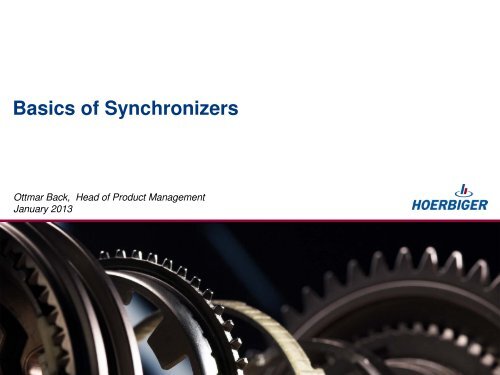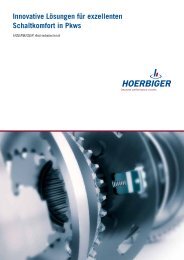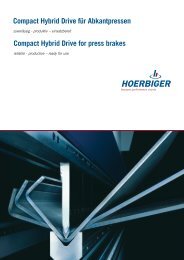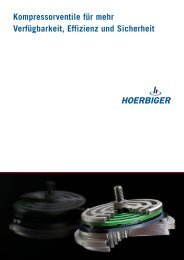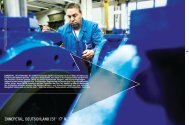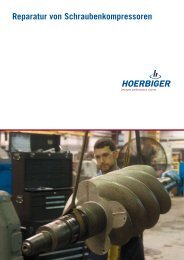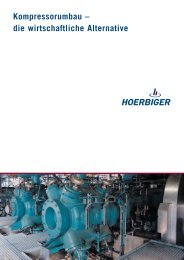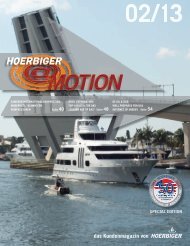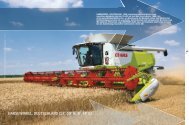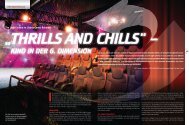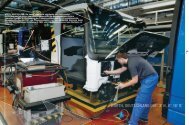2013_ Basics of Synchronizers - Hoerbiger
2013_ Basics of Synchronizers - Hoerbiger
2013_ Basics of Synchronizers - Hoerbiger
Create successful ePaper yourself
Turn your PDF publications into a flip-book with our unique Google optimized e-Paper software.
<strong>Basics</strong> <strong>of</strong> <strong>Synchronizers</strong><br />
Ottmar Back, Head <strong>of</strong> Product Management<br />
January <strong>2013</strong>
Content<br />
1. Introduction<br />
2. Driveline / Transmission / Shift Mechanism<br />
3. The Synchronization<br />
4. <strong>Basics</strong> for Synchronizer Calculation<br />
5. Interfaces<br />
6. Functional Problems and Solutions<br />
7. HOERBIGER Capabilities<br />
7.1. Design & Development<br />
7.2. Manufacturing<br />
8. HOERBIGER Product Portfolio<br />
9. Summary<br />
Copyright by HOERBIGER Antriebstechnik GmbH (Germany), <strong>2013</strong>. Any kind <strong>of</strong> use in part or in full provides HOERBIGER Antriebstechnik GmbH's prior written consent.<br />
<strong>Basics</strong> <strong>of</strong> <strong>Synchronizers</strong><br />
2
1. Introduction<br />
Copyright by HOERBIGER Antriebstechnik GmbH (Germany), <strong>2013</strong>. Any kind <strong>of</strong> use in part or in full provides HOERBIGER Antriebstechnik GmbH's prior written consent.<br />
<strong>Basics</strong> <strong>of</strong> <strong>Synchronizers</strong><br />
3
1. Introduction<br />
<strong>Synchronizers</strong> are the key elements in manual transmissions (MT) as well<br />
as in double-clutch transmissions (DCT) and automated manual<br />
transmissions (AMT).<br />
This paper gives an overview <strong>of</strong> their function, layout and design and<br />
explains possible problems and solutions.<br />
Finally it is shown what tools and processes are needed to develop, test<br />
and manufacture components and complete synchronizer systems.<br />
As the worldwide largest independent manufacturer HOERBIGER develops<br />
and supplies components and systems for all types <strong>of</strong> manual<br />
transmissions, double-clutch transmissions, and automated manual<br />
transmissions.<br />
Copyright by HOERBIGER Antriebstechnik GmbH (Germany), <strong>2013</strong>. Any kind <strong>of</strong> use in part or in full provides HOERBIGER Antriebstechnik GmbH's prior written consent.<br />
<strong>Basics</strong> <strong>of</strong> <strong>Synchronizers</strong><br />
4
2. Driveline / Transmission /<br />
Shift Mechanism<br />
Copyright by HOERBIGER Antriebstechnik GmbH (Germany), <strong>2013</strong>. Any kind <strong>of</strong> use in part or in full provides HOERBIGER Antriebstechnik GmbH's prior written consent.<br />
<strong>Basics</strong> <strong>of</strong> <strong>Synchronizers</strong><br />
5
2. Driveline / Transmission / Shift Mechanism<br />
<strong>Synchronizers</strong> are the central component <strong>of</strong> the transmission<br />
featuring interfaces to the output, the clutch and, by way <strong>of</strong> the gear<br />
shift, to the driver.<br />
The layout and design <strong>of</strong> the synchronizers play an essential role in<br />
how the driver experiences the gear shift.<br />
The following pages give an overview <strong>of</strong><br />
� the variety <strong>of</strong> driveline concepts<br />
� the interfaces <strong>of</strong> the transmission to the vehicle<br />
� the interface <strong>of</strong> the transmission to the driver and<br />
� the installation and the interfaces <strong>of</strong> the synchronizer in the<br />
transmission<br />
The layout and the design <strong>of</strong> synchronizer systems has to take into<br />
account all these aspects. The validation and the assessment <strong>of</strong> the<br />
synchronizer systems have to be made at test rig as well as in the<br />
vehicle.<br />
Copyright by HOERBIGER Antriebstechnik GmbH (Germany), <strong>2013</strong>. Any kind <strong>of</strong> use in part or in full provides HOERBIGER Antriebstechnik GmbH's prior written consent.<br />
<strong>Basics</strong> <strong>of</strong> <strong>Synchronizers</strong><br />
6
2. Driveline / Transmission / Shift Mechanism<br />
Driveline<br />
Copyright by HOERBIGER Antriebstechnik GmbH (Germany), <strong>2013</strong>. Any kind <strong>of</strong> use in part or in full provides HOERBIGER Antriebstechnik GmbH's prior written consent.<br />
<strong>Basics</strong> <strong>of</strong> <strong>Synchronizers</strong><br />
engine<br />
transmission<br />
7
2. Driveline / Transmission / Shift Mechanism<br />
Driveline<br />
stub axle<br />
shift lever<br />
constant velocity joint<br />
left (short) side shaft<br />
damper mass<br />
Copyright by HOERBIGER Antriebstechnik GmbH (Germany), <strong>2013</strong>. Any kind <strong>of</strong> use in part or in full provides HOERBIGER Antriebstechnik GmbH's prior written consent.<br />
<strong>Basics</strong> <strong>of</strong> <strong>Synchronizers</strong><br />
transmission<br />
right (long) side shaft<br />
constant velocity joint<br />
8
2. Driveline / Transmission / Shift Mechanism<br />
Transmission<br />
6<br />
4<br />
5<br />
side shaft<br />
left<br />
3<br />
2<br />
1<br />
R<br />
bell housing<br />
side shaft<br />
right<br />
Copyright by HOERBIGER Antriebstechnik GmbH (Germany), <strong>2013</strong>. Any kind <strong>of</strong> use in part or in full provides HOERBIGER Antriebstechnik GmbH's prior written consent.<br />
<strong>Basics</strong> <strong>of</strong> <strong>Synchronizers</strong><br />
4<br />
<strong>Synchronizers</strong> work as cone brakes. They<br />
brake or accelerate the components marked<br />
in blue and the secondary mass <strong>of</strong> the clutch.<br />
To synchronize means to adjust the speed <strong>of</strong><br />
shaft and gear wheel!<br />
3<br />
9
2. Driveline / Transmission / Shift Mechanism<br />
Shift Mechanism<br />
Shift<br />
Select<br />
Inner shift<br />
mechanism<br />
Copyright by HOERBIGER Antriebstechnik GmbH (Germany), <strong>2013</strong>. Any kind <strong>of</strong> use in part or in full provides HOERBIGER Antriebstechnik GmbH's prior written consent.<br />
<strong>Basics</strong> <strong>of</strong> <strong>Synchronizers</strong><br />
Outer shift<br />
mechanism<br />
10
3. The Synchronization<br />
Copyright by HOERBIGER Antriebstechnik GmbH (Germany), <strong>2013</strong>. Any kind <strong>of</strong> use in part or in full provides HOERBIGER Antriebstechnik GmbH's prior written consent.<br />
<strong>Basics</strong> <strong>of</strong> <strong>Synchronizers</strong><br />
11
3. The Synchronization<br />
<strong>Synchronizers</strong> can be structured by the number <strong>of</strong> cones used. The<br />
next 3 pages show the exploded views <strong>of</strong> single-, dual- and triple-cone<br />
synchronizers and the descriptions <strong>of</strong> the single components.<br />
The synchronization process always follows the same sequences. The<br />
sleeve is moved by the shift fork towards the gear to be engaged. As<br />
long as there is a speed difference between the sleeve/hub-system and<br />
the gear wheel the sleeve is blocked by the blocker ring and the<br />
synchronizer rings create a friction torque. When the speeds are<br />
synchronized the sleeve can be moved further and engages into the<br />
spline <strong>of</strong> the engangement ring at the gear wheel.<br />
The sequences can be followed by clicking through the pages 16 to 21.<br />
They are then explained in detail on pages 22 to 28.<br />
Copyright by HOERBIGER Antriebstechnik GmbH (Germany), <strong>2013</strong>. Any kind <strong>of</strong> use in part or in full provides HOERBIGER Antriebstechnik GmbH's prior written consent.<br />
<strong>Basics</strong> <strong>of</strong> <strong>Synchronizers</strong><br />
12
3. The Synchronization<br />
Single-cone Synchronizer<br />
Copyright by HOERBIGER Antriebstechnik GmbH (Germany), <strong>2013</strong>. Any kind <strong>of</strong> use in part or in full provides HOERBIGER Antriebstechnik GmbH's prior written consent.<br />
<strong>Basics</strong> <strong>of</strong> <strong>Synchronizers</strong><br />
13
3. The Synchronization<br />
Dual-cone Synchronizer<br />
Copyright by HOERBIGER Antriebstechnik GmbH (Germany), <strong>2013</strong>. Any kind <strong>of</strong> use in part or in full provides HOERBIGER Antriebstechnik GmbH's prior written consent.<br />
<strong>Basics</strong> <strong>of</strong> <strong>Synchronizers</strong><br />
14
3. The Synchronization<br />
Triple-cone Synchronizer<br />
Engagement ring<br />
Inner ring coated<br />
Intermediate ring<br />
Blocker ring<br />
Copyright by HOERBIGER Antriebstechnik GmbH (Germany), <strong>2013</strong>. Any kind <strong>of</strong> use in part or in full provides HOERBIGER Antriebstechnik GmbH's prior written consent.<br />
<strong>Basics</strong> <strong>of</strong> <strong>Synchronizers</strong><br />
Sleeve<br />
Hub<br />
Detent<br />
15
3. The Synchronization<br />
The Synchronization Process - Neutral<br />
Copyright by HOERBIGER Antriebstechnik GmbH (Germany), <strong>2013</strong>. Any kind <strong>of</strong> use in part or in full provides HOERBIGER Antriebstechnik GmbH's prior written consent.<br />
<strong>Basics</strong> <strong>of</strong> <strong>Synchronizers</strong><br />
16
3 .The Synchronization<br />
The Synchronization Process - Presynchronization<br />
Copyright by HOERBIGER Antriebstechnik GmbH (Germany), <strong>2013</strong>. Any kind <strong>of</strong> use in part or in full provides HOERBIGER Antriebstechnik GmbH's prior written consent.<br />
<strong>Basics</strong> <strong>of</strong> <strong>Synchronizers</strong><br />
17
3. The Synchronization<br />
The Synchronization Process - Synchronization<br />
Copyright by HOERBIGER Antriebstechnik GmbH (Germany), <strong>2013</strong>. Any kind <strong>of</strong> use in part or in full provides HOERBIGER Antriebstechnik GmbH's prior written consent.<br />
<strong>Basics</strong> <strong>of</strong> <strong>Synchronizers</strong><br />
18
3. The Synchronization<br />
The Synchronization Process - Blocking Release<br />
Copyright by HOERBIGER Antriebstechnik GmbH (Germany), <strong>2013</strong>. Any kind <strong>of</strong> use in part or in full provides HOERBIGER Antriebstechnik GmbH's prior written consent.<br />
<strong>Basics</strong> <strong>of</strong> <strong>Synchronizers</strong><br />
19
3. The Synchronization<br />
The Synchronization Process - Engagement<br />
Copyright by HOERBIGER Antriebstechnik GmbH (Germany), <strong>2013</strong>. Any kind <strong>of</strong> use in part or in full provides HOERBIGER Antriebstechnik GmbH's prior written consent.<br />
<strong>Basics</strong> <strong>of</strong> <strong>Synchronizers</strong><br />
20
3. The Synchronization<br />
The Synchronization Process - Gear shifted<br />
Copyright by HOERBIGER Antriebstechnik GmbH (Germany), <strong>2013</strong>. Any kind <strong>of</strong> use in part or in full provides HOERBIGER Antriebstechnik GmbH's prior written consent.<br />
<strong>Basics</strong> <strong>of</strong> <strong>Synchronizers</strong><br />
21
3. The Synchronization<br />
The Synchronization Process - neutral position<br />
Cross section, spline projected<br />
fork<br />
sleeve<br />
detent<br />
blocker ring<br />
engagement ring<br />
3D-picture<br />
Copyright by HOERBIGER Antriebstechnik GmbH (Germany), <strong>2013</strong>. Any kind <strong>of</strong> use in part or in full provides HOERBIGER Antriebstechnik GmbH's prior written consent.<br />
<strong>Basics</strong> <strong>of</strong> <strong>Synchronizers</strong><br />
22
3. The Synchronization<br />
The Synchronization Process - presynchronization<br />
- The fork is moving the sleeve in axial direction until the detents<br />
have contact with the blocker ring.<br />
- The detent force (50-100 N) creates a friction torque in the<br />
synchronizer.<br />
- This friction torque positions the blocker ring radially. I.e. the<br />
indexing lugs at the blocker ring bend to the pockets in the<br />
hub. This positions the blocking teeth at the blocker ring<br />
against the teeth <strong>of</strong> the sleeve.<br />
3D-picture<br />
Copyright by HOERBIGER Antriebstechnik GmbH (Germany), <strong>2013</strong>. Any kind <strong>of</strong> use in part or in full provides HOERBIGER Antriebstechnik GmbH's prior written consent.<br />
<strong>Basics</strong> <strong>of</strong> <strong>Synchronizers</strong><br />
23
3. The Synchronization<br />
The Synchronization Process - blocking position<br />
- With higher shift force the sleeve moves towards the<br />
blocking teeth <strong>of</strong> the blocker ring<br />
- The teeth <strong>of</strong> the sleeve push against the blocking<br />
teeth <strong>of</strong> the blocker ring<br />
- Speed difference is reduced until n1 = n2<br />
3D-picture<br />
Copyright by HOERBIGER Antriebstechnik GmbH (Germany), <strong>2013</strong>. Any kind <strong>of</strong> use in part or in full provides HOERBIGER Antriebstechnik GmbH's prior written consent.<br />
<strong>Basics</strong> <strong>of</strong> <strong>Synchronizers</strong><br />
24
3. The Synchronization<br />
The Synchronization Process - blocking release<br />
- At speed difference ‚0‘ i.e. n1=n2 the blocking<br />
condition is no longer valid.<br />
- The sleeve can turn back the blocker ring and<br />
move forward through the spline <strong>of</strong> the blocker ring.<br />
3D-picture<br />
Copyright by HOERBIGER Antriebstechnik GmbH (Germany), <strong>2013</strong>. Any kind <strong>of</strong> use in part or in full provides HOERBIGER Antriebstechnik GmbH's prior written consent.<br />
<strong>Basics</strong> <strong>of</strong> <strong>Synchronizers</strong><br />
25
3. The Synchronization<br />
The Synchronization Process - free flight phase<br />
- The sleeve moves forward towards the spline<br />
<strong>of</strong> the engagement ring.<br />
- In this phase a new speed difference between n1<br />
and n2 can occure.<br />
3D-picture<br />
Copyright by HOERBIGER Antriebstechnik GmbH (Germany), <strong>2013</strong>. Any kind <strong>of</strong> use in part or in full provides HOERBIGER Antriebstechnik GmbH's prior written consent.<br />
<strong>Basics</strong> <strong>of</strong> <strong>Synchronizers</strong><br />
26
3. The Synchronization<br />
The Synchronization Process - engagement<br />
- The sleeve enters into the engegement ring.<br />
- Speed differences between n1 and n2 can cause<br />
bumps at the entering into the engagement ring.<br />
3D-picture<br />
Copyright by HOERBIGER Antriebstechnik GmbH (Germany), <strong>2013</strong>. Any kind <strong>of</strong> use in part or in full provides HOERBIGER Antriebstechnik GmbH's prior written consent.<br />
<strong>Basics</strong> <strong>of</strong> <strong>Synchronizers</strong><br />
27
3. The Synchronization<br />
The Synchronization Process - gear shifted<br />
- When the sleeve has completly moved into the<br />
engagement ring the gear is shifted.<br />
- Back tapers at the teeth <strong>of</strong> the sleeve and the<br />
engagement ring avoid decoupling under load.<br />
3D-picture<br />
Copyright by HOERBIGER Antriebstechnik GmbH (Germany), <strong>2013</strong>. Any kind <strong>of</strong> use in part or in full provides HOERBIGER Antriebstechnik GmbH's prior written consent.<br />
<strong>Basics</strong> <strong>of</strong> <strong>Synchronizers</strong><br />
28
4. <strong>Basics</strong> for Synchronizer<br />
Calculation<br />
Copyright by HOERBIGER Antriebstechnik GmbH (Germany), <strong>2013</strong>. Any kind <strong>of</strong> use in part or in full provides HOERBIGER Antriebstechnik GmbH's prior written consent.<br />
<strong>Basics</strong> <strong>of</strong> <strong>Synchronizers</strong><br />
29
4. <strong>Basics</strong> for Synchronizer Calculation<br />
The dimensioning and calculation <strong>of</strong> synchronizers has to take into<br />
account numerous parameters. The developer has to ask his<br />
customers to provide the relevant data and also has to perform<br />
screening tests to determine the c.o.f. level and characteristic <strong>of</strong> the<br />
customer's transmission oil in interaction with the different friction<br />
linings.<br />
The capacity <strong>of</strong> a synchronizer has to be checked for the torque<br />
transmission when shifted and the synchronizing <strong>of</strong> speed difference.<br />
For torque transmitting components (sleeve, hub and engagement ring)<br />
standard FEM calculations are performed. For the calculation <strong>of</strong> the<br />
synchronizing system specific inhouse tools are in use.<br />
The following pages list the necessary input data which will enter into<br />
the calculation sheets. The pages 34 to 40 show the basic formula<br />
needed to calculate the blocking saftey and the load data for the<br />
friction cones.<br />
The characteristic values for different friction linings can be found in<br />
the data sheets in the download sector.<br />
Copyright by HOERBIGER Antriebstechnik GmbH (Germany), <strong>2013</strong>. Any kind <strong>of</strong> use in part or in full provides HOERBIGER Antriebstechnik GmbH's prior written consent.<br />
<strong>Basics</strong> <strong>of</strong> <strong>Synchronizers</strong><br />
30
4. <strong>Basics</strong> for Synchronizer Calculation<br />
Input<br />
� installation space<br />
� inertia to be synchronized<br />
� speed difference to be synchronized<br />
� torque to be transmitted<br />
� transmission oil<br />
� customers requirements (e.g. synchronizing time, shift travel,<br />
shift impulse, shift force, drag torque, load cycles, ...)<br />
� interfaces (spline data, clearance <strong>of</strong> gear wheels, sleeve groove...)<br />
� test definition for validation<br />
Copyright by HOERBIGER Antriebstechnik GmbH (Germany), <strong>2013</strong>. Any kind <strong>of</strong> use in part or in full provides HOERBIGER Antriebstechnik GmbH's prior written consent.<br />
<strong>Basics</strong> <strong>of</strong> <strong>Synchronizers</strong><br />
31
4. <strong>Basics</strong> for Synchronizer Calculation<br />
Limiting Factors<br />
The capacity <strong>of</strong> a synchronizer is limited by<br />
� torque capacity <strong>of</strong> Sleeve/Hub-System and Engagement Ring<br />
� capacity <strong>of</strong> Friction Material (sliding speed, surface pressure,<br />
friction power, friction work)<br />
� heat dissipation through the oil, the synchro rings and the gear cone<br />
� transmission oil (viscosity and thermal stability)<br />
(see also next page)<br />
Copyright by HOERBIGER Antriebstechnik GmbH (Germany), <strong>2013</strong>. Any kind <strong>of</strong> use in part or in full provides HOERBIGER Antriebstechnik GmbH's prior written consent.<br />
<strong>Basics</strong> <strong>of</strong> <strong>Synchronizers</strong><br />
32
4. <strong>Basics</strong> for Synchronizer Calculation<br />
Transmission Oil<br />
basic functions and requirements:<br />
� cooling<br />
� lubrication / wear protection<br />
� corrosion protection<br />
� anti foam<br />
� friction characteristic<br />
� compatibility with elastomeres (sealings)<br />
� temperature and viscosity characteristic<br />
Copyright by HOERBIGER Antriebstechnik GmbH (Germany), <strong>2013</strong>. Any kind <strong>of</strong> use in part or in full provides HOERBIGER Antriebstechnik GmbH's prior written consent.<br />
<strong>Basics</strong> <strong>of</strong> <strong>Synchronizers</strong><br />
low viscosity<br />
� screening test is necessary to determine the c.o.f. level and characteristic<br />
� viscosity determines drag torque and influences shift quality<br />
high viscosity<br />
33
4. <strong>Basics</strong> for Synchronizer Calculation<br />
Layout Calculation<br />
HOERBIGER inhouse calculation tools<br />
Copyright by HOERBIGER Antriebstechnik GmbH (Germany), <strong>2013</strong>. Any kind <strong>of</strong> use in part or in full provides HOERBIGER Antriebstechnik GmbH's prior written consent.<br />
<strong>Basics</strong> <strong>of</strong> <strong>Synchronizers</strong><br />
34
4. <strong>Basics</strong> for Synchronizer Calculation<br />
Calculation <strong>of</strong> Blocking Safety<br />
Friction Torque:<br />
T<br />
F<br />
=<br />
n<br />
c<br />
Blocking Safety:<br />
⋅ µ ⋅d<br />
m ⋅F<br />
2 ⋅ sinα<br />
T F<br />
a<br />
T T ><br />
F<br />
T Z<br />
Z<br />
Copyright by HOERBIGER Antriebstechnik GmbH (Germany), <strong>2013</strong>. Any kind <strong>of</strong> use in part or in full provides HOERBIGER Antriebstechnik GmbH's prior written consent.<br />
T<br />
=<br />
<strong>Basics</strong> <strong>of</strong> <strong>Synchronizers</strong><br />
Blocking Release Torque:<br />
Z<br />
F<br />
a<br />
dD<br />
⋅<br />
2<br />
Blocking safety is given if T F > T Z<br />
⋅<br />
cos<br />
sin<br />
β<br />
2<br />
β<br />
2<br />
− µ<br />
+ µ<br />
D<br />
D<br />
⋅ sin<br />
[Nm] [Nm]<br />
⋅cos<br />
α [°] cone angle<br />
β [°] chamfer angle<br />
µ [ - ] c.o.f. <strong>of</strong> cone<br />
µ D [ - ] c.o.f. <strong>of</strong> chamfers<br />
d m [mm] mean cone diameter<br />
d D [mm] pitch diameter<br />
F a [N] shift force at sleeve<br />
n c [ - ] number <strong>of</strong> cones<br />
β<br />
2<br />
β<br />
2<br />
35
4. <strong>Basics</strong> for Synchronizer Calculation<br />
Calculation <strong>of</strong> specific friction work q A<br />
W<br />
A<br />
W = ( −J⋅<br />
∆ω<br />
± T )<br />
V ⋅∆ω⋅<br />
tR<br />
qA = 2<br />
[J/mm²]<br />
1<br />
2<br />
t R [s] slipping time<br />
T V [Nm] drag torque<br />
ω = ∆n<br />
× 2π /<br />
∆ SYN<br />
J [kgm²] mass moment <strong>of</strong> inertia<br />
n SYN [min -1 ] speed difference to synchronize<br />
A [mm²] total friction surface<br />
W [J] friction work<br />
Copyright by HOERBIGER Antriebstechnik GmbH (Germany), <strong>2013</strong>. Any kind <strong>of</strong> use in part or in full provides HOERBIGER Antriebstechnik GmbH's prior written consent.<br />
<strong>Basics</strong> <strong>of</strong> <strong>Synchronizers</strong><br />
60<br />
36
4. <strong>Basics</strong> for Synchronizer Calculation<br />
Calculation <strong>of</strong> mean specific friction power P mA<br />
P =<br />
mA<br />
q<br />
t<br />
A<br />
R<br />
[W/mm²]<br />
or<br />
P<br />
mA=<br />
t R [s] slipping time<br />
Copyright by HOERBIGER Antriebstechnik GmbH (Germany), <strong>2013</strong>. Any kind <strong>of</strong> use in part or in full provides HOERBIGER Antriebstechnik GmbH's prior written consent.<br />
P<br />
A<br />
P m [W] mean friction power<br />
q A [J/mm²] specific friction work<br />
A [mm²] total friction surface<br />
W [J] friction work<br />
m<br />
[W/mm²]<br />
<strong>Basics</strong> <strong>of</strong> <strong>Synchronizers</strong><br />
P =<br />
m<br />
W<br />
t<br />
R<br />
37
4. <strong>Basics</strong> for Synchronizer Calculation<br />
Calculation <strong>of</strong> max. sliding speed v max<br />
v max ∆nSYN<br />
60 × ×<br />
= / π d<br />
Copyright by HOERBIGER Antriebstechnik GmbH (Germany), <strong>2013</strong>. Any kind <strong>of</strong> use in part or in full provides HOERBIGER Antriebstechnik GmbH's prior written consent.<br />
max<br />
d max [mm] max. cone diameter<br />
[m/s]<br />
n SYN [min -1 ] speed difference to synchronize<br />
<strong>Basics</strong> <strong>of</strong> <strong>Synchronizers</strong><br />
38
4. <strong>Basics</strong> for Synchronizer Calculation<br />
Calculation <strong>of</strong> mean specific pressure p m<br />
FN<br />
p m = [N/mm²]<br />
F N = ( TF<br />
/( µ × dm<br />
/ 2))<br />
/ nc<br />
( A / nc)<br />
T F = J×<br />
∆ / tR<br />
t R [s] slipping time<br />
J [kgm²] mass moment <strong>of</strong> inertia<br />
T F [Nm] friction torque<br />
n c [ - ] number <strong>of</strong> cones<br />
d m [mm] mean cone diameter<br />
µ [ - ] coefficient <strong>of</strong> friction c.o.f.<br />
F N [N] normal force on cone<br />
A [mm²] total friction surface<br />
Copyright by HOERBIGER Antriebstechnik GmbH (Germany), <strong>2013</strong>. Any kind <strong>of</strong> use in part or in full provides HOERBIGER Antriebstechnik GmbH's prior written consent.<br />
<strong>Basics</strong> <strong>of</strong> <strong>Synchronizers</strong><br />
ω<br />
39
4. <strong>Basics</strong> for Synchronizer Calculation<br />
Calculation <strong>of</strong> max. specific friction power P max<br />
P max = pm<br />
× v max×<br />
µ<br />
[W]<br />
µ [ - ] coeffiecient <strong>of</strong> friction c.o.f.<br />
v max [m/s] max. sliding speed<br />
p m [N/mm²] mean specific pressure<br />
Copyright by HOERBIGER Antriebstechnik GmbH (Germany), <strong>2013</strong>. Any kind <strong>of</strong> use in part or in full provides HOERBIGER Antriebstechnik GmbH's prior written consent.<br />
<strong>Basics</strong> <strong>of</strong> <strong>Synchronizers</strong><br />
40
4. <strong>Basics</strong> for Synchronizer Calculation<br />
Characteristic values for calculated parameters<br />
Copyright by HOERBIGER Antriebstechnik GmbH (Germany), <strong>2013</strong>. Any kind <strong>of</strong> use in part or in full provides HOERBIGER Antriebstechnik GmbH's prior written consent.<br />
<strong>Basics</strong> <strong>of</strong> <strong>Synchronizers</strong><br />
41
5. Interfaces<br />
Copyright by HOERBIGER Antriebstechnik GmbH (Germany), <strong>2013</strong>. Any kind <strong>of</strong> use in part or in full provides HOERBIGER Antriebstechnik GmbH's prior written consent.<br />
<strong>Basics</strong> <strong>of</strong> <strong>Synchronizers</strong><br />
42
5. Interfaces<br />
The definition <strong>of</strong> interfaces between the synchronizer system and the<br />
transmission is essential for a proper function and durability.<br />
� The neutral position <strong>of</strong> the shift fork determines the clearance <strong>of</strong> the<br />
synchronizer rings. Low clearance will cause drag torque and in<br />
extreme cases overheat and destroy the friction lining.<br />
� The clearance <strong>of</strong> the gear wheels determine the maximum possible<br />
axial space for the synchro rings. Too much clearance can cause a<br />
decoupling <strong>of</strong> blocker rings from the hub or what is more likely from<br />
blocker rings and inner rings in multi-cone synchronizers.<br />
Copyright by HOERBIGER Antriebstechnik GmbH (Germany), <strong>2013</strong>. Any kind <strong>of</strong> use in part or in full provides HOERBIGER Antriebstechnik GmbH's prior written consent.<br />
<strong>Basics</strong> <strong>of</strong> <strong>Synchronizers</strong><br />
43
5. Interfaces<br />
Shift Fork / Gear Wheel<br />
The neutral position <strong>of</strong> the shift fork should<br />
not exceed +/- 0,35 mm.<br />
The clearance between hub and gear wheel<br />
should not exceed 0,4 mm.<br />
Copyright by HOERBIGER Antriebstechnik GmbH (Germany), <strong>2013</strong>. Any kind <strong>of</strong> use in part or in full provides HOERBIGER Antriebstechnik GmbH's prior written consent.<br />
<strong>Basics</strong> <strong>of</strong> <strong>Synchronizers</strong><br />
Drawing shows gear wheels touching the hub<br />
44
6. Functional Problems and<br />
Solutions<br />
Copyright by HOERBIGER Antriebstechnik GmbH (Germany), <strong>2013</strong>. Any kind <strong>of</strong> use in part or in full provides HOERBIGER Antriebstechnik GmbH's prior written consent.<br />
<strong>Basics</strong> <strong>of</strong> <strong>Synchronizers</strong><br />
45
6. Functional Problems and Solutions<br />
During development and testing functional problems have to be<br />
detected and solutions have to be fixed.<br />
Typical problems and possible solutions are summarized on the next<br />
pages.<br />
� To avoid functional problems already in the design phase it is<br />
necessary to combine long-time experience and high level <strong>of</strong> data<br />
quality.<br />
� To solve occuring problems a detailed analysis has to be carried out<br />
in advance by recording shift curves in the vehicle or transmission<br />
test rig.<br />
� Solutions can be developed and tested first in a simulation model<br />
before manufacturing prototypes for validation in the vehicle.<br />
Copyright by HOERBIGER Antriebstechnik GmbH (Germany), <strong>2013</strong>. Any kind <strong>of</strong> use in part or in full provides HOERBIGER Antriebstechnik GmbH's prior written consent.<br />
<strong>Basics</strong> <strong>of</strong> <strong>Synchronizers</strong><br />
46
6. Functional Problems and Solutions<br />
Shift Force F a too high<br />
F<br />
a<br />
=<br />
2 ⋅ sinα<br />
⋅ J ⋅ ∆ϖ<br />
n ⋅ µ ⋅d<br />
⋅t<br />
To reduce the shift force following measures can be taken:<br />
� increase diameter d m<br />
� increase number <strong>of</strong> cones n c<br />
� increase c.o.f. (friction lining, oil)<br />
� reduce cone angle α<br />
c<br />
! to avoid self-locking µ < tanα<br />
m<br />
F<br />
Copyright by HOERBIGER Antriebstechnik GmbH (Germany), <strong>2013</strong>. Any kind <strong>of</strong> use in part or in full provides HOERBIGER Antriebstechnik GmbH's prior written consent.<br />
<strong>Basics</strong> <strong>of</strong> <strong>Synchronizers</strong><br />
47
6. Functional Problems and Solutions<br />
Shift Quality - 2 nd load bump<br />
The 2 nd load bump occurs when the sleeve enters into the engagement ring. If the<br />
resistance is too high, it can be felt at the shift knob.<br />
shift force<br />
shift travel<br />
Low 2 nd load bump High 2 nd load bump<br />
Copyright by HOERBIGER Antriebstechnik GmbH (Germany), <strong>2013</strong>. Any kind <strong>of</strong> use in part or in full provides HOERBIGER Antriebstechnik GmbH's prior written consent.<br />
<strong>Basics</strong> <strong>of</strong> <strong>Synchronizers</strong><br />
48
6. Functional Problems and Solutions<br />
Shift Quality - 2 nd load bump<br />
The 2 nd load bump occurs when the sleeve enters into the engagement ring. If the<br />
resistance is too high it can be felt at the shift knob.<br />
Reasons for 2 nd load bumps can be:<br />
� high drag torque, esp. in cold transmission > reduces input speed in free<br />
flight phase<br />
� high friction torque T F , > oscillation <strong>of</strong> driveline<br />
� losses in shift system > high friction in cable shift<br />
� clutch not 100% open<br />
Possible measures:<br />
� low viscosity oil, low friction bearings<br />
� reduced chamfer angle (blocking safety must be respected)<br />
� reduced losses in shift system (low friction cable shift)<br />
Copyright by HOERBIGER Antriebstechnik GmbH (Germany), <strong>2013</strong>. Any kind <strong>of</strong> use in part or in full provides HOERBIGER Antriebstechnik GmbH's prior written consent.<br />
<strong>Basics</strong> <strong>of</strong> <strong>Synchronizers</strong><br />
49
6. Functional Problems and Solutions<br />
Shift Quality - clash<br />
Clash occurs when the blocking safety is not given. In this case the sleeve moves<br />
towards the engagement ring before the speed difference has been synchronized.<br />
blocking safety:<br />
T Z<br />
T ><br />
T F<br />
F<br />
T<br />
Z<br />
clash event<br />
Copyright by HOERBIGER Antriebstechnik GmbH (Germany), <strong>2013</strong>. Any kind <strong>of</strong> use in part or in full provides HOERBIGER Antriebstechnik GmbH's prior written consent.<br />
<strong>Basics</strong> <strong>of</strong> <strong>Synchronizers</strong><br />
shift force<br />
shift travel<br />
50
6. Functional Problems and Solutions<br />
Shift Quality - clash<br />
Clash occurs when the blocking safety is not given. In this case the sleeve moves<br />
towards the engagement ring before the speed difference has been synchronized.<br />
Reasons for clash can be:<br />
� c.o.f. too low for design layout<br />
� c.o.f. changes over lifetime > degradation <strong>of</strong> lining or oil<br />
� oil viscosity too high at low temperature > cold clash<br />
� high wear > loss <strong>of</strong> wear gap<br />
Possible measures:<br />
� increase blocking safety (chamfer angle, cone angle, friction lining)<br />
� improve groove geometry (cold clash)<br />
� improve c.o.f. increase in presynchronization (detent force)<br />
� increase wear gap<br />
Copyright by HOERBIGER Antriebstechnik GmbH (Germany), <strong>2013</strong>. Any kind <strong>of</strong> use in part or in full provides HOERBIGER Antriebstechnik GmbH's prior written consent.<br />
<strong>Basics</strong> <strong>of</strong> <strong>Synchronizers</strong><br />
51
6. Functional Problems and Solutions<br />
Shift Quality - clash<br />
A specific reason for clash can also be extreme wear and/or drop <strong>of</strong> c.o.f. due to an<br />
overheating <strong>of</strong> the friction rings<br />
Reasons for overheating can be:<br />
� misuse (shifting against closed clutch, ...)<br />
� insufficient design (e.g. too small clearance, ...)<br />
� shift fork position decentralized<br />
Possible measures:<br />
� instruction <strong>of</strong> drivers<br />
� reduce tolerances for gear clearance<br />
� install detent to center the sleeve to the hub<br />
Copyright by HOERBIGER Antriebstechnik GmbH (Germany), <strong>2013</strong>. Any kind <strong>of</strong> use in part or in full provides HOERBIGER Antriebstechnik GmbH's prior written consent.<br />
<strong>Basics</strong> <strong>of</strong> <strong>Synchronizers</strong><br />
52
6. Functional Problems and Solutions<br />
Shift Quality - gear jump out<br />
After the gear has been shifted the sleeve decouples from the engagement ring.<br />
Reasons for gear jump out can be:<br />
� back taper angle too small<br />
� tumbling <strong>of</strong> the sleeve due to run out failures at the connected parts<br />
Copyright by HOERBIGER Antriebstechnik GmbH (Germany), <strong>2013</strong>. Any kind <strong>of</strong> use in part or in full provides HOERBIGER Antriebstechnik GmbH's prior written consent.<br />
<strong>Basics</strong> <strong>of</strong> <strong>Synchronizers</strong><br />
53
6. Functional Problems and Solutions<br />
Shift Quality - blocking <strong>of</strong> 1 st - or R-gear<br />
Gear can‘t be engaged when the vehicle is not moving<br />
Reasons for blocking <strong>of</strong> 1 st - and R-gear:<br />
� self-locking (µ > tanα)<br />
� double engagement<br />
� detent not released<br />
� clutch not 100% open<br />
Copyright by HOERBIGER Antriebstechnik GmbH (Germany), <strong>2013</strong>. Any kind <strong>of</strong> use in part or in full provides HOERBIGER Antriebstechnik GmbH's prior written consent.<br />
<strong>Basics</strong> <strong>of</strong> <strong>Synchronizers</strong><br />
54
7. HOERBIGER Capabilities<br />
7.1. Design & Development<br />
Copyright by HOERBIGER Antriebstechnik GmbH (Germany), <strong>2013</strong>. Any kind <strong>of</strong> use in part or in full provides HOERBIGER Antriebstechnik GmbH's prior written consent.<br />
<strong>Basics</strong> <strong>of</strong> <strong>Synchronizers</strong><br />
55
7.1. Design & Development<br />
Strategic Target <strong>of</strong> HOERBIGER Product Development is<br />
‚Technological Cost Leadership‘.<br />
Under Technological Cost Leadership we assume the capability to simplify the overall<br />
synchronizer system to generate functional high-value synchronizer systems at costs<br />
below those <strong>of</strong> todays state <strong>of</strong> the art synchronizers<br />
The Technological Cost Leadership enables us to <strong>of</strong>fer to our customers taylored system<br />
design with the best price-performance ratio.<br />
To achieve this ambitious target it is essential<br />
� to posses fundamental knowledge on tribology, materials and production processes and<br />
� to fully understand the requirements for function and durability <strong>of</strong> synchronizer<br />
components and systems,<br />
� to apply suitable tools for calculations, simulations and design,<br />
� to make use <strong>of</strong> relevant test rigs for validation <strong>of</strong> function and durability and<br />
� to be able to assess shift quality by measurement and subjective evaluation.<br />
Copyright by HOERBIGER Antriebstechnik GmbH (Germany), <strong>2013</strong>. Any kind <strong>of</strong> use in part or in full provides HOERBIGER Antriebstechnik GmbH's prior written consent.<br />
<strong>Basics</strong> <strong>of</strong> <strong>Synchronizers</strong><br />
56
7.1. Design & Development<br />
Development Tools<br />
Simulation<br />
Tribology<br />
Development follows Stage-Gate Pocess<br />
Copyright by HOERBIGER Antriebstechnik GmbH (Germany), <strong>2013</strong>. Any kind <strong>of</strong> use in part or in full provides HOERBIGER Antriebstechnik GmbH's prior written consent.<br />
<strong>Basics</strong> <strong>of</strong> <strong>Synchronizers</strong><br />
Testing<br />
Design<br />
57
7.1. Design & Development<br />
Development Tools<br />
Concept Layout / Design<br />
� System Layout<br />
� Concept Definition<br />
� Design Engineering<br />
� Analysis <strong>of</strong> Functionality<br />
� Optimization <strong>of</strong> existing Systems<br />
Copyright by HOERBIGER Antriebstechnik GmbH (Germany), <strong>2013</strong>. Any kind <strong>of</strong> use in part or in full provides HOERBIGER Antriebstechnik GmbH's prior written consent.<br />
<strong>Basics</strong> <strong>of</strong> <strong>Synchronizers</strong><br />
58
7.1. Design & Development<br />
Development Tools<br />
Modeling<br />
� modular model design<br />
� efficient modeling<br />
� adapted to vehicle environment<br />
� dynamic 3-dimensional visualization<br />
Simulation<br />
� statistical parameter variation<br />
� parameter variation with DoE<br />
� analysis <strong>of</strong> complex interactions<br />
and optimization <strong>of</strong> subsystems<br />
Validation<br />
� check <strong>of</strong> characteristic values at components<br />
� system validation by rig and vehicle measurements<br />
Shift fork +<br />
Sleeve<br />
Catch<br />
Shift tube +<br />
Shift weight<br />
Shift rope<br />
Copyright by HOERBIGER Antriebstechnik GmbH (Germany), <strong>2013</strong>. Any kind <strong>of</strong> use in part or in full provides HOERBIGER Antriebstechnik GmbH's prior written consent.<br />
Shift lever<br />
<strong>Basics</strong> <strong>of</strong> <strong>Synchronizers</strong><br />
59
7.1. Design & Development<br />
Development Tools<br />
� tribometer<br />
� synchronizer test rig HOERBIGER µ-comp<br />
� synchronizer test rig ZF SSP180<br />
� torsional and linear pulser<br />
� transmission test rig<br />
� drive train test rig<br />
� in vehicle shift quality measurement<br />
Copyright by HOERBIGER Antriebstechnik GmbH (Germany), <strong>2013</strong>. Any kind <strong>of</strong> use in part or in full provides HOERBIGER Antriebstechnik GmbH's prior written consent.<br />
<strong>Basics</strong> <strong>of</strong> <strong>Synchronizers</strong><br />
60
7.1. Design & Development<br />
HOERBIGER µcomp Synchronizer Test Rig<br />
El. Engine<br />
Inc. Angle<br />
Detector<br />
Flywheel(s)<br />
Copyright by HOERBIGER Antriebstechnik GmbH (Germany), <strong>2013</strong>. Any kind <strong>of</strong> use in part or in full provides HOERBIGER Antriebstechnik GmbH's prior written consent.<br />
<strong>Basics</strong> <strong>of</strong> <strong>Synchronizers</strong><br />
Potentiometer Hydraulic<br />
Cylinder<br />
Oil Outlet<br />
Measurement<br />
Device<br />
Oil<br />
Supply<br />
Shift<br />
Fork<br />
Center<br />
Shaft<br />
Synchro<br />
Unit<br />
Base<br />
Frame<br />
© <strong>Hoerbiger</strong><br />
Antriebstechnik -<br />
1097RR<br />
61
7.1. Design & Development<br />
HOERBIGER Shift Simulator<br />
Copyright by HOERBIGER Antriebstechnik GmbH (Germany), <strong>2013</strong>. Any kind <strong>of</strong> use in part or in full provides HOERBIGER Antriebstechnik GmbH's prior written consent.<br />
<strong>Basics</strong> <strong>of</strong> <strong>Synchronizers</strong><br />
62
7.2. Manufacturing<br />
Copyright by HOERBIGER Antriebstechnik GmbH (Germany), <strong>2013</strong>. Any kind <strong>of</strong> use in part or in full provides HOERBIGER Antriebstechnik GmbH's prior written consent.<br />
<strong>Basics</strong> <strong>of</strong> <strong>Synchronizers</strong><br />
63
7.2. Manufacturing<br />
As a result <strong>of</strong> the efficient and flexible use <strong>of</strong> metal forming technology, machining, heat<br />
treatment, and friction lining production, HOERBIGER has efficient manufacturing<br />
technologies at its disposal - with sustainable cost advantages for the customer.<br />
� Metal-forming and Machining<br />
HOERBIGER employs powerful metal-forming presses and modern machining equipment to produce<br />
ready-to-install synchronizer components and systems. In-house tool & die design as well as<br />
automated production lines assure high quality standards. This consistently allows HOERBIGER to<br />
<strong>of</strong>fer products with excellent features at an excellent cost-benefit ratio.<br />
� Heat treatment<br />
Modern heat treating equipment assures high-quality as well as careful finishing <strong>of</strong> HOERBIGER<br />
synchronizer components.<br />
� Friction lining production (sintered and carbon linings)<br />
HOERBIGER manufactures all sintered friction linings in-house. Moreover, HOERBIGER <strong>of</strong>fers a wide<br />
range <strong>of</strong> specially developed carbon friction linings. Sintered and carbon friction linings are applied to<br />
the synchronizer rings in automated equipment.<br />
From highly complex components to complete ready-to-install systems:<br />
HOERBIGER always <strong>of</strong>fers customers outstanding products<br />
in the best quality at a balanced cost-benefit ratio.<br />
Copyright by HOERBIGER Antriebstechnik GmbH (Germany), <strong>2013</strong>. Any kind <strong>of</strong> use in part or in full provides HOERBIGER Antriebstechnik GmbH's prior written consent.<br />
<strong>Basics</strong> <strong>of</strong> <strong>Synchronizers</strong><br />
64
7.2. Manufacturing<br />
Production Technologies - overview<br />
Innovative products and systems through excellence in production and technology<br />
� machining<br />
� metal forming technology<br />
� heat treatment<br />
� friction material production and friction material bonding<br />
� assembly<br />
� testing technology<br />
We set standards through top quality and state-<strong>of</strong>-the-art technology.<br />
Copyright by HOERBIGER Antriebstechnik GmbH (Germany), <strong>2013</strong>. Any kind <strong>of</strong> use in part or in full provides HOERBIGER Antriebstechnik GmbH's prior written consent.<br />
<strong>Basics</strong> <strong>of</strong> <strong>Synchronizers</strong><br />
65
7.2. Manufacturing<br />
Production Technologies for Sleeves + Engagment Rings<br />
… a unique combination <strong>of</strong> processes<br />
� turning<br />
� milling<br />
� broaching<br />
� chamfering<br />
� back taper milling<br />
� heat treatment<br />
� washing<br />
Copyright by HOERBIGER Antriebstechnik GmbH (Germany), <strong>2013</strong>. Any kind <strong>of</strong> use in part or in full provides HOERBIGER Antriebstechnik GmbH's prior written consent.<br />
<strong>Basics</strong> <strong>of</strong> <strong>Synchronizers</strong><br />
66
7.2. Manufacturing<br />
Production Technologies for Synchro Rings<br />
… complex components are produced in their final shape (net shape)<br />
� deep drawing<br />
� stamping<br />
� fine blanking<br />
� cold forming<br />
� bending<br />
� heat treatment<br />
Copyright by HOERBIGER Antriebstechnik GmbH (Germany), <strong>2013</strong>. Any kind <strong>of</strong> use in part or in full provides HOERBIGER Antriebstechnik GmbH's prior written consent.<br />
<strong>Basics</strong> <strong>of</strong> <strong>Synchronizers</strong><br />
67
7.2. Manufacturing<br />
Production Technologies for Friction Linings<br />
… unique product portfolio<br />
� manufacturing <strong>of</strong> sintered metallic linings<br />
� manufacturing <strong>of</strong> carbon linings<br />
� bonding <strong>of</strong> sintered and carbon linings<br />
Copyright by HOERBIGER Antriebstechnik GmbH (Germany), <strong>2013</strong>. Any kind <strong>of</strong> use in part or in full provides HOERBIGER Antriebstechnik GmbH's prior written consent.<br />
<strong>Basics</strong> <strong>of</strong> <strong>Synchronizers</strong><br />
68
7.2. Manufacturing<br />
Assembly and Testing<br />
… pre-finished and fully-automatic for ready-to-install systems<br />
� friction systems<br />
� sleeve/hub systems<br />
� complete synchronizer groups<br />
� running-in<br />
� functional testing<br />
Copyright by HOERBIGER Antriebstechnik GmbH (Germany), <strong>2013</strong>. Any kind <strong>of</strong> use in part or in full provides HOERBIGER Antriebstechnik GmbH's prior written consent.<br />
<strong>Basics</strong> <strong>of</strong> <strong>Synchronizers</strong><br />
69
8. HOERBIGER Product Portfolio<br />
Copyright by HOERBIGER Antriebstechnik GmbH (Germany), <strong>2013</strong>. Any kind <strong>of</strong> use in part or in full provides HOERBIGER Antriebstechnik GmbH's prior written consent.<br />
<strong>Basics</strong> <strong>of</strong> <strong>Synchronizers</strong><br />
70
8. HOERBIGER Product Portfolio<br />
Synchronizer Systems<br />
� Most innovative and competent partner for<br />
synchronizer development<br />
� Unique portfolio <strong>of</strong> development tools for<br />
simulation, testing & assessment<br />
� First adress for solving <strong>of</strong> problems<br />
regarding shift comfort and reliability<br />
HOERBIGER - SKS Line<br />
The synchronizer without blocking teeth<br />
�� 1 Cone System 1CS<br />
�� 2 Cone System 2CS<br />
Copyright by HOERBIGER Antriebstechnik GmbH (Germany), <strong>2013</strong>. Any kind <strong>of</strong> use in part or in full provides HOERBIGER Antriebstechnik GmbH's prior written consent.<br />
<strong>Basics</strong> <strong>of</strong> <strong>Synchronizers</strong><br />
HOERBIGER - Classic Line<br />
The proven synchronizer for all applications<br />
�� 1 Cone System 1CS<br />
�� 2 Cone System 2CS<br />
�� 3 Cone System 3CS<br />
71
8. HOERBIGER Product Portfolio<br />
Friction Systems<br />
HOERBIGER - Classic Line<br />
The proven synchronizer for all applications<br />
�� 2 Cone System 2CS<br />
�� 3 Cone System 3CS<br />
�� with HS Sinter or HC Carbon Lining<br />
Copyright by HOERBIGER Antriebstechnik GmbH (Germany), <strong>2013</strong>. Any kind <strong>of</strong> use in part or in full provides HOERBIGER Antriebstechnik GmbH's prior written consent.<br />
<strong>Basics</strong> <strong>of</strong> <strong>Synchronizers</strong><br />
� First in market with sheet metal formed<br />
friction systems<br />
� In high volume series production since 1999<br />
� Best reliabilty for wide range <strong>of</strong> applications<br />
� Problem solver in terms <strong>of</strong> shift quality,<br />
efficiency and durability<br />
72
8. HOERBIGER Product Portfolio<br />
Blocker Rings<br />
HOERBIGER - Classic Line<br />
The proven synchronizer for all applications<br />
�� BRC with HC Carbon Lining<br />
�� BRC with HS Sinter Lining<br />
�� BRE with HS Sinter Lining<br />
Copyright by HOERBIGER Antriebstechnik GmbH (Germany), <strong>2013</strong>. Any kind <strong>of</strong> use in part or in full provides HOERBIGER Antriebstechnik GmbH's prior written consent.<br />
<strong>Basics</strong> <strong>of</strong> <strong>Synchronizers</strong><br />
� Only HOERBIGER can <strong>of</strong>fer Sinter and<br />
Carbon friction linings in sheet metal rings<br />
� In high volume series production for MT and<br />
DCT applications for successful OEMS and<br />
gearbox manufacturers<br />
� Excellent quality records due to fully<br />
automated manufacturing lines<br />
� Due to better wear resistance also as<br />
replacement for brass rings with<br />
molybdenum coating<br />
73
8. HOERBIGER Product Portfolio<br />
Synchronizer Sleeves<br />
HOERBIGER - Classic Line<br />
The proven synchronizer for all applications<br />
�� Sliding Sleeves from rolled blanks<br />
Copyright by HOERBIGER Antriebstechnik GmbH (Germany), <strong>2013</strong>. Any kind <strong>of</strong> use in part or in full provides HOERBIGER Antriebstechnik GmbH's prior written consent.<br />
<strong>Basics</strong> <strong>of</strong> <strong>Synchronizers</strong><br />
� HOERBIGER produces sleeves with an<br />
experience <strong>of</strong> more than 75 years<br />
� Most modern production equipment has<br />
been developed exclusively with leading<br />
machine suppliers like Präwema<br />
� In-house process chain including production<br />
<strong>of</strong> rolled blanks ensures optimal quality<br />
control<br />
� High volume production in place at two<br />
production sites in Germany and one in<br />
China<br />
� Quality in regards <strong>of</strong> spline error and<br />
chamfer angles as well as safety against<br />
cracks and breakage superior compared to<br />
sheet metal or powder metal sleeves<br />
74
8. HOERBIGER Product Portfolio<br />
Engagement Rings<br />
HOERBIGER - Classic Line<br />
The proven synchronizer for all applications<br />
�� Engagement Rings from stamped blanks<br />
Copyright by HOERBIGER Antriebstechnik GmbH (Germany), <strong>2013</strong>. Any kind <strong>of</strong> use in part or in full provides HOERBIGER Antriebstechnik GmbH's prior written consent.<br />
<strong>Basics</strong> <strong>of</strong> <strong>Synchronizers</strong><br />
� HOERBIGER combines in-house know how<br />
on stamping and machining<br />
� High volume production since decades<br />
� Highest quality in regards <strong>of</strong> spline error<br />
and chamfer angles<br />
75
9. Summary<br />
Copyright by HOERBIGER Antriebstechnik GmbH (Germany), <strong>2013</strong>. Any kind <strong>of</strong> use in part or in full provides HOERBIGER Antriebstechnik GmbH's prior written consent.<br />
<strong>Basics</strong> <strong>of</strong> <strong>Synchronizers</strong><br />
76
9. Summary<br />
By supplying the synchronizer, HOERBIGER provides the central<br />
component <strong>of</strong> the transmission featuring interfaces to the output, the<br />
clutch and, by way <strong>of</strong> the gear shift, to the driver.<br />
The layout and design <strong>of</strong> the synchronizers play an essential role in<br />
how the driver experiences the gear shift.<br />
Long lasting experience is needed for the development <strong>of</strong><br />
synchronizer components and systems. The vertical integration <strong>of</strong> all<br />
production steps ensures highest quality and cost effectivness.<br />
Close cooperation between HOERBIGER and its customers is<br />
required to achieve reliable and comfortable sychronizer solutions.<br />
Copyright by HOERBIGER Antriebstechnik GmbH (Germany), <strong>2013</strong>. Any kind <strong>of</strong> use in part or in full provides HOERBIGER Antriebstechnik GmbH's prior written consent.<br />
<strong>Basics</strong> <strong>of</strong> <strong>Synchronizers</strong><br />
77
Copyright by HOERBIGER Antriebstechnik GmbH (Germany), <strong>2013</strong>. Any kind <strong>of</strong> use in part or in full provides HOERBIGER Antriebstechnik GmbH's prior written consent.<br />
<strong>Basics</strong> <strong>of</strong> <strong>Synchronizers</strong><br />
78


